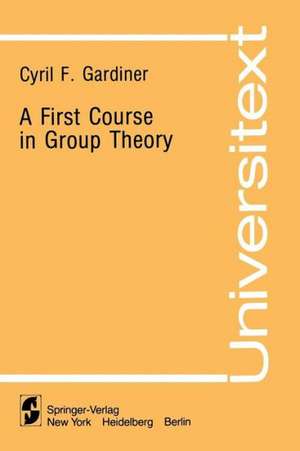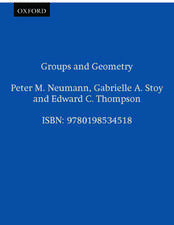A First Course in Group Theory: Universitext
Autor Cyril F. Gardineren Limba Engleză Paperback – 19 ian 1981
Din seria Universitext
- 13%
 Preț: 353.48 lei
Preț: 353.48 lei -
 Preț: 418.67 lei
Preț: 418.67 lei -
 Preț: 465.61 lei
Preț: 465.61 lei -
 Preț: 358.44 lei
Preț: 358.44 lei - 17%
 Preț: 394.41 lei
Preț: 394.41 lei - 15%
 Preț: 737.46 lei
Preț: 737.46 lei - 17%
 Preț: 364.56 lei
Preț: 364.56 lei - 15%
 Preț: 543.75 lei
Preț: 543.75 lei - 15%
 Preț: 497.21 lei
Preț: 497.21 lei -
 Preț: 634.38 lei
Preț: 634.38 lei -
 Preț: 360.93 lei
Preț: 360.93 lei - 17%
 Preț: 431.50 lei
Preț: 431.50 lei - 13%
 Preț: 355.51 lei
Preț: 355.51 lei - 17%
 Preț: 364.81 lei
Preț: 364.81 lei -
 Preț: 396.53 lei
Preț: 396.53 lei - 17%
 Preț: 365.34 lei
Preț: 365.34 lei - 15%
 Preț: 553.33 lei
Preț: 553.33 lei -
 Preț: 371.98 lei
Preț: 371.98 lei -
 Preț: 673.45 lei
Preț: 673.45 lei - 15%
 Preț: 509.58 lei
Preț: 509.58 lei - 17%
 Preț: 427.32 lei
Preț: 427.32 lei - 17%
 Preț: 426.76 lei
Preț: 426.76 lei - 17%
 Preț: 427.68 lei
Preț: 427.68 lei - 20%
 Preț: 569.54 lei
Preț: 569.54 lei -
 Preț: 356.77 lei
Preț: 356.77 lei - 17%
 Preț: 369.06 lei
Preț: 369.06 lei - 19%
 Preț: 429.21 lei
Preț: 429.21 lei -
 Preț: 487.96 lei
Preț: 487.96 lei - 20%
 Preț: 628.22 lei
Preț: 628.22 lei -
 Preț: 372.86 lei
Preț: 372.86 lei -
 Preț: 319.07 lei
Preț: 319.07 lei -
 Preț: 379.86 lei
Preț: 379.86 lei -
 Preț: 445.88 lei
Preț: 445.88 lei -
 Preț: 382.36 lei
Preț: 382.36 lei - 15%
 Preț: 533.72 lei
Preț: 533.72 lei - 15%
 Preț: 496.02 lei
Preț: 496.02 lei - 15%
 Preț: 474.82 lei
Preț: 474.82 lei -
 Preț: 389.70 lei
Preț: 389.70 lei -
 Preț: 484.08 lei
Preț: 484.08 lei - 15%
 Preț: 469.48 lei
Preț: 469.48 lei - 15%
 Preț: 643.48 lei
Preț: 643.48 lei -
 Preț: 415.02 lei
Preț: 415.02 lei - 15%
 Preț: 602.25 lei
Preț: 602.25 lei - 20%
 Preț: 510.24 lei
Preț: 510.24 lei - 15%
 Preț: 588.37 lei
Preț: 588.37 lei -
 Preț: 381.59 lei
Preț: 381.59 lei -
 Preț: 489.87 lei
Preț: 489.87 lei -
 Preț: 493.89 lei
Preț: 493.89 lei - 20%
 Preț: 332.24 lei
Preț: 332.24 lei
Preț: 384.86 lei
Nou
Puncte Express: 577
Preț estimativ în valută:
73.66€ • 75.91$ • 62.19£
73.66€ • 75.91$ • 62.19£
Carte tipărită la comandă
Livrare economică 01-15 martie
Preluare comenzi: 021 569.72.76
Specificații
ISBN-13: 9780387905457
ISBN-10: 0387905456
Pagini: 228
Ilustrații: X, 228 p.
Dimensiuni: 155 x 235 x 13 mm
Greutate: 0.34 kg
Ediția:Softcover reprint of the original 1st ed. 1980
Editura: Springer
Colecția Springer
Seria Universitext
Locul publicării:New York, NY, United States
ISBN-10: 0387905456
Pagini: 228
Ilustrații: X, 228 p.
Dimensiuni: 155 x 235 x 13 mm
Greutate: 0.34 kg
Ediția:Softcover reprint of the original 1st ed. 1980
Editura: Springer
Colecția Springer
Seria Universitext
Locul publicării:New York, NY, United States
Public țintă
ResearchCuprins
1 First Ideas.- 1.1 Introduction.- 1.2 The Definition of a Group.- 1.3 The General Associative Law.- 1.4 Further Examples of Groups.- 1.5 Aims.- Exercises 1.- 2 Multiplication Table, Generators, Relations, Isomorphism.- 2.1 Multiplication Table.- 2.2 Multiplication Table for the Dihedral Group D3.- 2.3 Order of an Element.- 2.4 The Symmetric Group Sn.- 2.5 Isomorphism n.- 2.6 Generators and Relations.- 2.7 All Possible Groups of Orders 1, 2, 3, 4.- 2.8 Some Results on Orders of Elements.- Exercises 2.- 3 Subgroups, Lagrange’s Theorem, Cyclic Groups.- 3.1 Cosets and Lagrange’s Theorem.- 3.2 Some Results on Subgroups.- 3.3 Generators.- 3.4 Products of Subsets of Groups.- 3.5 Cyclic Groups.- 3.6 Subgroups of S3.- Exercises 3.- 4 Factor Groups, Permutation Representations, Finite Point Groups.- 4.1 Normal Subgroups.- 4.2 Simplicity.- 4.3 Conjugacy.- 4.4 Conjugacy Classes.- 4.5 Homomorphisms.- 4.6 Permutation Representation of a Group.- 4.7 Subgroups of Factor Groups.- 4.8 Factor Groups of Factor Groups.- 4.9 Groups of Order p2, p prime.- 4.10 Symmetry and the Orthogonal Group.- 4.11 Classification of the Finite Rotation Groups.- 4.12 Examples of Finite Rotation Groups.- 4.13 Classification of Finite Point Groups of the Second Kind.- 4.14 Examples of Some of the Finite Point Groups of the Second Kind.- Exercises 4.- 5 Finitely Generated Abelian Groups.- 5.1 Introduction.- 5.2 Direct Sum.- 5.3 Free Abelian Groups.- 5.4 Structure Theorems for Finitely Generated Abelian Groups.- 5.5 Uniqueness.- 5.6 Possible Groups of Order p2.- Exercises 5.- 6 The Sylow Theorems.- 6.1 Introduction.- 6,2 Double Cosets.- 6.3 The Sylow Theorems.- 6.4 Applications of the Sylow Theorems.- Exercises 6.- 7 Groups of Orders 1 To 15.- 7.1 Introduction.- 7.2 Groups of Order 6.- 7.3 Groups of Order7.- 7.4 Groups of Order 8.- 7.5 Groups of Order 9.- 7.6 Groups of Order 10.- 7.7 Groups of Order 11.- 7.8 Groups of Order 12.- 7.9 Groups of Order 13.- 7.10 Groups of Order 14.- 7.11 Groups of Order 15.- 7.12 Summary.- Exercises 7.- 8 Epilogue.- 8.1 Introduction.- 8.2 Construction of Finite Groups.- 8.3 Solvable and Nilpotent Groups.- 8.4 The Isomorphism Theorems.- 8.5 The Schreier-Jordan-Hölder Theorem.- 8.6 Some Basic Results on Solvable Groups.- Exercises 8.- Miscellaneous Exercises.- Outline Solutions to the Exercises.- Exercises 1.- Exercises 2.- Exercises 3.- Exercises 4.- Exercises 5.- Exercises 6.- Exercises 7.- Exercises 8.- Miscellaneous Exercises.- Further Reading and References.- Intermèdiate.- Advanced.- Sources of Further Problems.- References.- Further Reading and References for Scientists.- General Reference.















